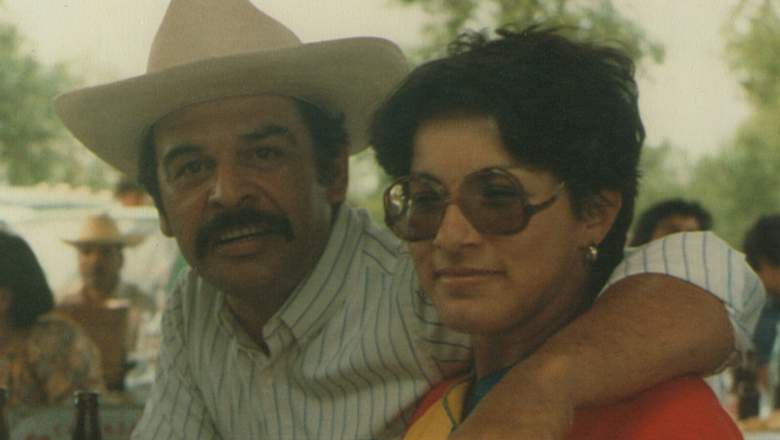
Amazon Prime Video A never-before-seen photo of DEA Agent Enrique "Kiki" Camarena with his wife Geneva "Mika" Camarena. The photo was taken in Guadalajara in 1980.
On Friday, July 31, Amazon Video is premiering four-part docuseries called The Last Narc, which features interviews with government and cartel insiders in the hopes of unpacking “the shocking political conspiracy surrounding the kidnapping and murder of DEA Agent Enrique “Kiki” Camarena.”
Ahead of the docuseries premiere, here’s what you need to know about Camarena’s work, life, and death.
Camarena Joined the DEA in 1975
Born and raised in Mexico and California, Camarena graduated from high school in 1966 and then joined the United States Marine Corps, according to his DEA biography. After he left the corps, he briefly served as a police officer in his home town of Calexico, California where he became a Special Agent on the Imperial County Narcotic Task Force. Then in 1974, he joined the Drug Enforcement Administration (DEA).
In 1981, Camarena was transferred to Guadalajara, Mexico where he worked to hunt down cartels responsible for marijuana and cocaine trafficking. He worked there for four years before he was murdered.
Camarena Was Abducted and Murdered in 1985
In 1984-85, Camarena was working on a major case against “Rancho Bufalo,” a marijuana plantation. When Mexican soldiers destroyed the plantation based on information from Camarena, he was kidnapped in broad daylight on the way to meet his wife, Mika, for lunch. It was February 7, 1985. Also abducted in the kidnapping was Camarena’s Mexican reconnaissance pilot Alfredo Zavala Avelar.
The bodies were not found for over a month. In that time, U.S. authorities started a massive operation to find him, stopping and searching every car that was passing from Mexico to the U.S., according to Cannabis Culture.
But Camarena and Avelar weren’t in a vehicle. They were being held by the Guadalajara Cartel in a nearby house where they were tortured for days. According to the DEA, they believe Camarena was alive for two days following his abduction. In fact, the DEA eventually received an audiotape of the torture session that lasted nine hours and ended in the deaths of both men. It sparked the largest manhunt in DEA history.
The Trial
It was difficult for the DEA to investigate and make arrests in the Camarena case because of a strained relationship with the Mexican government and corrupt Mexican officials who worked to cover up the kidnapping and murder.
But eventually, four defendants were held accountable, though not directly. According to the New York Times, Javier Vasquez Velasco, a bodyguard for a drug trafficker, was found guilty of beating two tourists to death whom he had mistaken for DEA agents.
He was not charged with acts directly tied to Camarena’s death, but he received life in prison for the tourists’ deaths.
“There is justice in the fact that many of those responsible for the brutal kidnapping, torture, and murder of Special Agent Camarena have now been held accountable for their dreadful acts,” Attorney General Dick Thornburgh said in a statement.
Juan Ramon Matta Ballesteros, Juan Jose Bernabe Ramirez, and Ruben Zuno Arce, the brother-in-law of a former Mexican president, were convicted of kidnapping Camarena during the same trial. None of them were actually convicted in Camarena’s murder.
Camarenas Legacy
Camarena was survived by his wife, Mika, and his three sons, who were ages 11, 6 and 4 at the time of his death. In 2004, Mika formed the Enrique S. Camarena Foundation with the help of several retired DEA agents and her oldest son, who is named after his father and who worked as a deputy district attorney in the San Diego area (he is now a judge). In a 2016 interview, Mika told the San Diego Union-Tribune what her husband would say to her today, “Don’t give up the war. Don’t give it up because they’ll win. The only ones who will lose will be us. Our youth will lose.”
She also explained how Red Ribbon week came to be after her husband was murdered.
“We, in Calexico, started wearing red ribbons after Kiki was murdered. Now, more than 80,000 students celebrate Red Ribbon Week each year (Oct. 23-31). Whenever I speak at schools, I tell teachers and students that drugs aren’t there for a week or two, but all year round. We hand out red ribbons. I tell them to take it home and discuss its meaning with their parents so they’re aware, too. They need to observe Red Ribbon Week year round.”
The Last Narc is out now on Amazon.